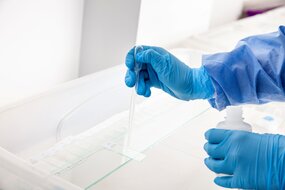Immunohistochemistry
Immunohistochemistry (IHC) is a microscope-based imaging technique that allows for the visualization of cell components - such as proteins - within a tissue sample. IHC works by using antibodies that are conjugated to enzymes which form detectable compounds, allowing identification of specific antigens.
IHC is a useful technique because it is both quantitative and qualitative, allowing for information that can be used to determine the distribution and localization of cell components within sample cells or tissues.
The purpose of IHC is to identify the location of specific antigens within a tissue sample, which makes it an important diagnostic tool to identify and study tumours, cancers, and infectious diseases.

What Is the Purpose of IHC?
IHC is an important technique used in healthcare and pathology to analyze molecules of interest in relation to both healthy and diseased tissues.
Why Use IHC?
IHC techniques are popular in how they detect and analyze protein expression without destroying the composition of the sample. Maintaining this composition is important when diagnosing any cell abnormalities with respect to the structure of cells and surrounding tissues.
How Does IHC Work?
IHC is a type of immunostaining technique based on the specific recognition of a target antigen by an antibody.
To begin, a 4-7µm thick tissue section is affixed to a glass slide. In order to prevent non-specific staining, the slide is blocked with a buffer containing irrelevant proteins, before one or more antibodies specific to the target proteins of interest are incubated on the slide.
Signal development in IHC is based on enzymatic reactions leading to the deposition of a colored precipitate onto the slide.
Either an enzyme-conjugated primary antibody or a primary-secondary pair can be used; the most commonly used enzymes in IHC are horseradish peroxidase (HRP) or alkaline phosphatase (AP).
Different substrates produce different colored stains. The most commonly observed colors in IHC stains include brown (substrate, DAB) and red (substrate, AEC). The limit to the number of proteins that can be marked on a single slide by IHC is limited only by the number of differently colored enzyme-substrate complexes available; typically, IHC is used to visualize one or two proteins.
After the enzyme-substrate reaction has taken place, the slide is counterstained with hematoxylin, a blue stain that marks cell nuclei. IHC slides can be viewed by light microscopes at a low magnification to view protein distribution over an entire section, or at a high magnification to analyze specific cells or tissue regions.
Immunohistochemistry Resources
View some of our additional resources in regards to an immunohistochemistry overview and testing methodologies.
- An Introduction to Multiplex Immunohistochemistry
- Practical Overview of Multiplex Immunohistochemistry using TSA
- Benefits of Fluorescent Multiplex Immunohistochemistry using Tyramide Signal Amplification
- Retrieval buffers: Citrate vs. Tris-EDTA
Immunoperoxidase Protocols
- FFPE tissues and cell blocks
- Epitope Retrieval Method for FFPE tissues and cell block
- Formaldehyde-Fixed Cells and Cytospin Preparations
- Cells Grown in Culture and Cytospin Preparations
Immunofluorescence Protocols
Immunohistochemistry FAQs
How do you qualify IHC antibodies for IHC?
Are there advantages to using immunoperoxidase (DAB) over immunofluorescence (IF) for IHC?
When is it best to use IF?
What positive tissue control should I use?
How long should FFPE tissues be fixed to be suitable for immunohistochemistry?